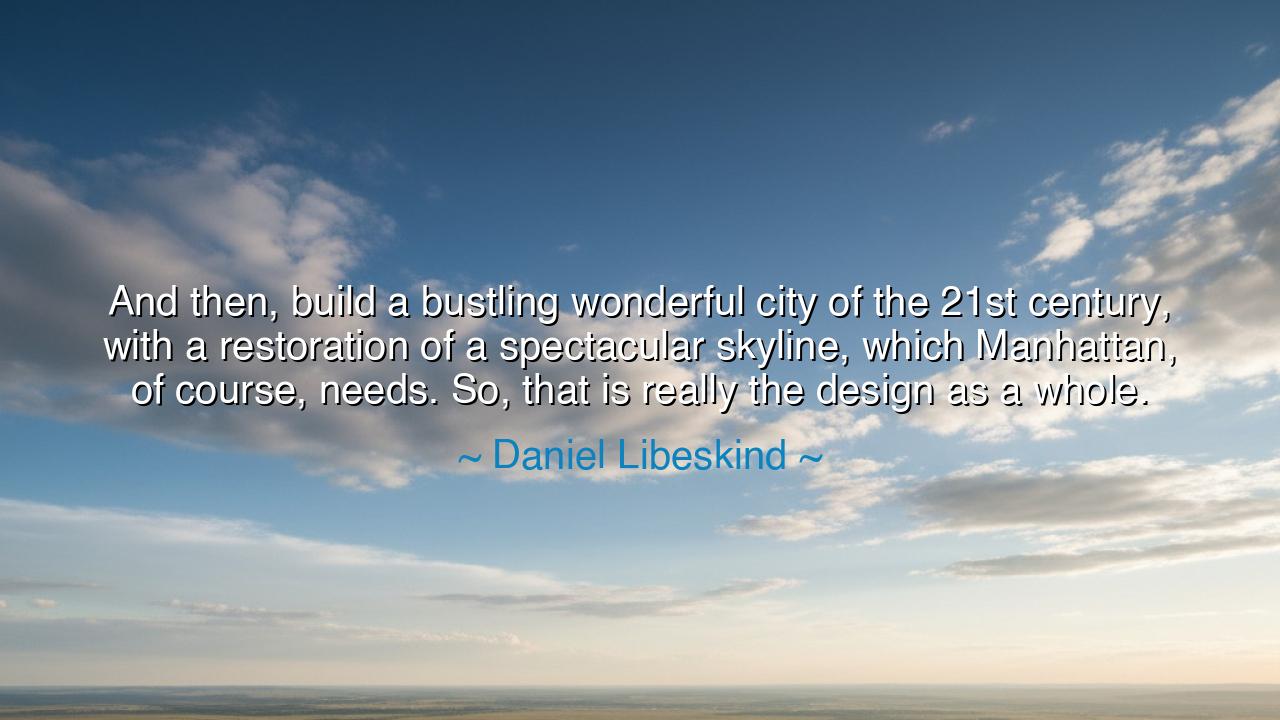
And then, build a bustling wonderful city of the 21st century
And then, build a bustling wonderful city of the 21st century, with a restoration of a spectacular skyline, which Manhattan, of course, needs. So, that is really the design as a whole.






“And then, build a bustling wonderful city of the 21st century, with a restoration of a spectacular skyline, which Manhattan, of course, needs. So, that is really the design as a whole.” – Daniel Libeskind
In these stirring words, Daniel Libeskind, the visionary architect who reimagined the heart of lower Manhattan after tragedy, speaks not merely of construction, but of rebirth. His statement carries the weight of both sorrow and hope — a reminder that architecture is not only the shaping of space, but the healing of spirit. When he speaks of building a “bustling wonderful city,” he does not mean only glass, steel, and streets — he means life itself: the rhythm of footsteps, the laughter of strangers, the defiant hum of existence returning where silence once reigned. His vision, born from the ashes of loss, is the ancient truth made new — that through creation, humankind overcomes destruction.
The origin of this quote lies in Libeskind’s role as the master planner for the rebuilding of the World Trade Center site after the September 11 attacks. It was his task not merely to restore buildings, but to restore meaning. The skyline of Manhattan — once crowned by the Twin Towers — had become both a wound and a symbol. To rebuild it was to declare that New York, and humanity itself, could rise again. Thus, when Libeskind speaks of the “restoration of a spectacular skyline,” he is invoking an act both architectural and spiritual. The skyline, for him, is the soul of a city made visible, the upward gesture of a people who will not bow to despair.
Yet, Libeskind’s words reach far beyond Manhattan. They speak to every civilization that has ever fallen and risen again. From the ruins of Athens after the Persian wars, to Rome reborn after fire, to the cities of Europe rebuilt from the rubble of the Second World War — humanity’s story is one of continual rebuilding. Each time we raise new walls, we are not just constructing cities; we are asserting our existence, proclaiming that life still has purpose. In this sense, the act of design becomes a moral act — a form of resistance against entropy and forgetting. To build is to say, “We remember, and we continue.”
Consider Warsaw, Libeskind’s own birthplace, a city that was nearly erased during World War II. Its heart was shattered, its people scattered. Yet in the decades that followed, it was rebuilt — brick by brick, memory by memory — until its Old Town once more stood proud, a testament to endurance. Libeskind’s philosophy springs from such histories. For him, architecture is not about replacing what was lost, but about transforming grief into renewal. His Manhattan design carried that same essence — it honored the fallen while giving the living a place to dream again. It was, in his own words, “a design as a whole” — a vision uniting remembrance, innovation, and life.
When he calls for a city of the 21st century, Libeskind is not only speaking of modern technology or futuristic forms. He is calling for a city shaped by human values — openness, resilience, and connection. A “bustling” city, yes, but one alive with meaning. The ancients understood this balance well: they built their temples not only for gods, but for the soul of their people. The Parthenon, the Great Wall, the cathedrals of Europe — all were acts of creation that embodied both progress and reverence. Libeskind calls us to recover that same sacred ambition in our time: to build not only higher, but truer.
The lesson is clear: in every era of destruction, the answer lies not in retreat, but in creation. When the world falls silent with loss, the builder must raise their hands. The artist, the architect, the thinker — all become healers of the collective heart. To build something new, something “wonderful,” is to give the future a shape it can believe in. We must each become, in our own way, designers of restoration — rebuilding our cities, our communities, our relationships, and even our faith in humanity.
So, dear listener, let Libeskind’s vision be your guide: build with courage, restore with love, and design with remembrance. Do not fear the ruins that life leaves behind, for they are the foundations of tomorrow. Whether your craft is architecture, art, teaching, or kindness itself — let it serve as your skyline, rising toward light after darkness. For as Libeskind reminds us, the true design — the design as a whole — is not made of concrete or glass, but of the enduring will of humanity to rise, rebuild, and renew.






AAdministratorAdministrator
Welcome, honored guests. Please leave a comment, we will respond soon